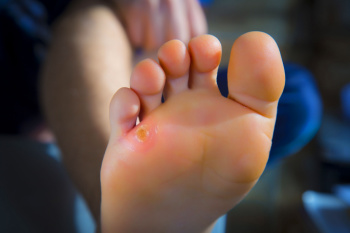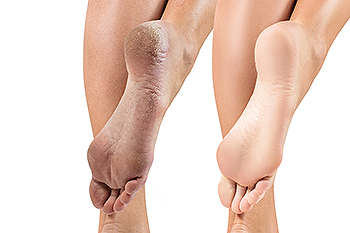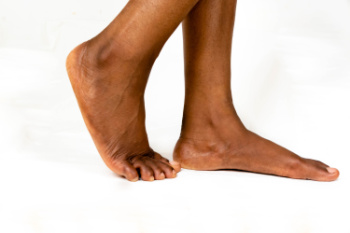Call Us Today! (203) 975-9600
SAME DAY APPOINTMENTS AVAILABLE
May 2024
Causes and Relief Solutions for Corns

Corns, commonly found on the feet, are thickened areas of skin that develop in response to repeated friction or pressure. They typically appear on weight-bearing areas like the toes, soles, or sides of the feet, where friction from footwear or underlying bone abnormalities occurs. Corns may present as hard or soft, depending on their location and the presence of moisture. While they are generally harmless, they can cause discomfort, pain, and even inflammation if left untreated. Relief solutions for corns often involve alleviating pressure and reducing friction in affected areas. Wearing properly fitting footwear with ample toe room and cushioning can help prevent corns from worsening. Additionally, using protective pads or inserts can provide padding and reduce friction. In more severe cases, seeking professional assistance from a podiatrist may be necessary for safe and effective removal of corns. Having a corn on the foot can be uncomfortable. If you have developed a corn, it is suggested that you visit a podiatrist who can provide you with effective relief and prevention tips.
Corns can make walking very painful and should be treated immediately. If you have questions regarding your feet and ankles, contact one of our podiatrists of Preferred Footcare, LLC. Our doctors will treat your foot and ankle needs.
Corns: What Are They? And How Do You Get Rid of Them?
Corns are thickened areas on the skin that can become painful. They are caused by excessive pressure and friction on the skin. Corns press into the deeper layers of the skin and are usually round in shape.
Ways to Prevent Corns
There are many ways to get rid of painful corns such as:
- Wearing properly fitting shoes that have been measured by a professional
- Wearing shoes that are not sharply pointed or have high heels
- Wearing only shoes that offer support
Treating Corns
Although most corns slowly disappear when the friction or pressure stops, this isn’t always the case. Consult with your podiatrist to determine the best treatment option for your case of corns.
If you have any questions please feel free to contact our office located in Stamford, CT . We offer the newest diagnostic and treatment technologies for all your foot and ankle needs.
Causes and Symptoms of Heel Fissures

Heel fissures are cracks in the skin over your heels that can range from minor discomfort to serious health concerns. Symptoms include can mild discoloration, thickening of the skin, visible splitting of the skin, and bleeding. Without treatment, heel fissures can worsen, leading to open wounds, pain, and even deep ulcers susceptible to infections like cellulitis. Dry skin on the heels is a primary cause of fissures, worsened by conditions such as diabetes, eczema, and fungal infections. Due to damaged foot nerves and decreased moisture, diabetic patients are particularly at risk for heel fissures that progress into non-healing ulcers. To manage symptoms of heel fissures, regular moisturizing is recommended, in addition to exfoliation with alpha hydroxy acids or urea-based creams. If the heel fissures continue to worsen, seeking medical attention from a podiatrist is suggested. This foot doctor can provide specialized debridement to remove thickened skin and prescribe medication to combat infections. If dry skin on your feet is causing problems like heel fissures, it is suggested that you schedule an appointment with a podiatrist.
If the skin on your feet starts to crack, you may want to see a podiatrist to find treatment. If you have any concerns, contact one of our podiatrists from Preferred Footcare, LLC. Our doctors can provide the care you need to keep you pain-free and on your feet.
Cracked Heels
It is important to moisturize your cracked heels in order to prevent pain, bleeding, and infection. The reason cracked heels form is because the skin on the foot is too dry to support the immense pressure placed on them. When the foot expands, the dry skin on the foot begins to split.
Ways to Help Heal Them
- Invest in a good foot cream
- Try Using Petroleum Jelly
- Ease up on Soaps
- Drink Plenty of Water
Ways to Prevent Cracked Heels
- Moisturize After Showering
- Skip a Shower
- Keep Shower Water Lukewarm
- Don’t Scrub Your Feet
If you are unsure how to proceed in treating cracked heels, seek guidance from a podiatrist. Your doctor will help you with any questions or information you may need.
If you have any questions, please feel free to contact our office located in Stamford, CT . We offer the newest diagnostic and treatment technologies for all your foot care needs.
Custom Orthotics For Outdoor Activity

Embrace the great outdoors with confidence and comfort! Whether you're hiking, jogging, or exploring nature, Custom Orthotics are your perfect companion. Tailored to your foot's unique needs, they provide stability on uneven terrains and cushioning for those longer adventures. Don't let foot discomfort limit your outdoor experiences. With Custom Orthotics, every step is supported and secure. Call today to schedule an appointment.
Shoes That Can Help Flat Feet

Finding the right shoes for flat feet is important for both comfort and foot health. Flat feet can vary in shape and size, from toes pointing outward to tight Achilles tendons. Experts suggest opting for wide-fit shoes to accommodate your foot shape and avoiding narrow fronts, allowing your toes to spread comfortably. Look for shoes with sturdy soles and heel support to prevent overpronation and protect against potential tendon damage. Custom orthotic inserts can provide personalized support, reduce strain, and help keep your feet aligned. Reinforced heels are essential to safeguard against pressure to protect the Achilles tendon. Consider wearing different types of shoes for various activities, ensuring you have the right support for each occasion. During the summer, prioritize wide, sturdy soles with ample cushioning. While wearing quality shoes is essential, it is suggested that you consult a podiatrist for an examination and tailored advice on managing flat feet.
Flatfoot is a condition many people suffer from. If you have flat feet, contact one of our podiatrists from Preferred Footcare, LLC. Our doctors will treat your foot and ankle needs.
What Are Flat Feet?
Flatfoot is a condition in which the arch of the foot is depressed and the sole of the foot is almost completely in contact with the ground. About 20-30% of the population generally has flat feet because their arches never formed during growth.
Conditions & Problems:
Having flat feet makes it difficult to run or walk because of the stress placed on the ankles.
Alignment – The general alignment of your legs can be disrupted, because the ankles move inward which can cause major discomfort.
Knees – If you have complications with your knees, flat feet can be a contributor to arthritis in that area.
Symptoms
- Pain around the heel or arch area
- Trouble standing on the tip toe
- Swelling around the inside of the ankle
- Flat look to one or both feet
- Having your shoes feel uneven when worn
Treatment
If you are experiencing pain and stress on the foot you may weaken the posterior tibial tendon, which runs around the inside of the ankle.
If you have any questions please feel free to contact our office located in Stamford, CT . We offer the newest diagnostic and treatment technologies for all your foot and ankle needs.
Why Live with Pain and Numbness in Your Feet?
Benefits of Custom Orthotics for Neurological Conditions

Custom orthotics are tailor-made shoe inserts designed to address specific foot issues and improve overall foot function. They can correct biomechanical imbalances, provide support, and alleviate pain, making them invaluable for individuals with neurological conditions like cerebral palsy or traumatic brain injury, where spasticity affects foot function. When prescribing custom orthotics, podiatrists consider factors such as foot structure, gait mechanics, and the individual's unique needs. For those with neurological conditions, orthotics can help manage spasticity-related foot deformities, improve stability, and enhance mobility. The evaluation process typically involves assessing foot alignment, analyzing gait patterns, and identifying areas of discomfort or dysfunction. Podiatrists work closely with patients to develop personalized orthotic solutions that address their specific challenges and promote optimal foot health and function. If you or a loved one is struggling with foot issues related to a neurological condition, it is suggested that you see a podiatrist who can provide valuable guidance and support in finding relief through custom orthotics.
Discover relief from persistent foot pain with custom orthotics and shoe inserts. If you’re battling heel pain, these personalized solutions offer targeted support, addressing the root causes of discomfort. Customized to your unique biomechanics, these inserts provide stability, alleviating both heel and foot pain. Say goodbye to the agony of every step and hello to a life free from constant foot pain. Invest in your well-being with custom orthotics or shoe inserts ensuring your feet receive the care they deserve. Step confidently, step comfortably – because a pain-free journey begins with the right support.
If you have any questions please contact our office located in Stamford, CT . We offer the newest diagnostic and treatment technologies for all your foot and ankle needs.
Why Did I Develop a Heel Spur?

Heel spurs, bony protrusions that develop on the underside of the heel bone, can cause considerable pain and discomfort, making everyday activities such as walking or standing challenging. These spurs form in response to repeated strain or stress on the foot's ligaments and muscles, typically as a result of biomechanical issues or excessive pressure on the heel. Common contributing factors include wearing ill-fitting shoes, overuse during physical activities such as running or jumping, obesity, or having a flat or high arch. Additionally, age-related changes in foot structure and chronic conditions like plantar fasciitis or arthritis can increase the likelihood of heel spur development. While heel spurs may not always cause symptoms, they can exacerbate pain and inflammation in surrounding tissues, leading to discomfort and reduced mobility. A heel spur is treated by a podiatrist. If you have developed this condition, it is suggested that you consult this type of doctor who can accurately diagnose and treat heel spurs.
Heel spurs can be incredibly painful and sometimes may make you unable to participate in physical activities. To get medical care for your heel spurs, contact one of our podiatrists from Preferred Footcare, LLC. Our doctors will do everything possible to treat your condition.
Heels Spurs
Heel spurs are formed by calcium deposits on the back of the foot where the heel is. This can also be caused by small fragments of bone breaking off one section of the foot, attaching onto the back of the foot. Heel spurs can also be bone growth on the back of the foot and may grow in the direction of the arch of the foot.
Older individuals usually suffer from heel spurs and pain sometimes intensifies with age. One of the main condition's spurs are related to is plantar fasciitis.
Pain
The pain associated with spurs is often because of weight placed on the feet. When someone is walking, their entire weight is concentrated on the feet. Bone spurs then have the tendency to affect other bones and tissues around the foot. As the pain continues, the feet will become tender and sensitive over time.
Treatments
There are many ways to treat heel spurs. If one is suffering from heel spurs in conjunction with pain, there are several methods for healing. Medication, surgery, and herbal care are some options.
If you have any questions feel free to contact our office located in Stamford, CT . We offer the latest in diagnostic and treatment technology to meet your needs.









